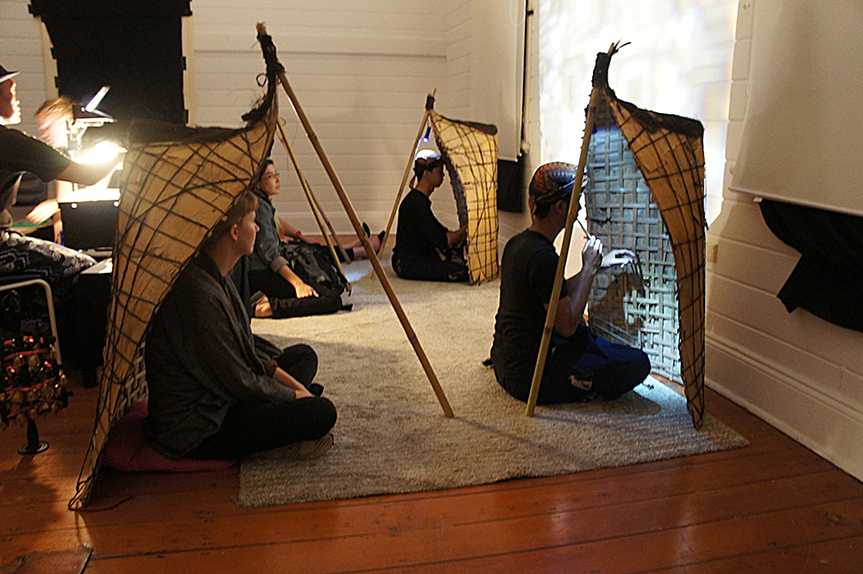
R
E
V N
E
X
T
There were eight of us in the audience for Indonesian-born, Australia-based artist Jumaadi’s shadow puppet play, The Sound of Shadows, that took place early February in a 100-year-old wooden building located on a remote and wild promontory that jutted into Sydney Harbour. Aside from the audience, the crowded, darkened room held four musicians, a dancer, Jumaadi himself and various musical instruments—stringed instruments, gongs, a xylophone and four bundengans, which are devices from Wonosobo in Central Java made from woven bamboo that are part hat, part shelter, and can be described as “musical capes” that produce a sound softer than the metallic cluck of gamelans. It was an intensely intimate gathering. Among the guests were Elizabeth Ann Macgregor, director of Sydney’s Museum of Contemporary Art, and Jo-Anne Birnie Danzker, the CEO of the Biennale of Sydney.
Australian composer Bianca Gannon penned the score for The Sound of Shadows. In each quarter-hour, Jumaadi’s musical partners delivered extensive aural range, with the music swelling from subdued notes to an unrestrained, boisterous cacophony. The dancer rattled what resembled a sistrum and voiced incantations as puppet shadows leapt across the cathedral ceiling before settling back on the screen. Throughout the performance, trees, landscapes, animalistic figures and multi-eyed characters moved fitfully into and out of frame.
The story tells of Jumaadi’s broad concerns for the environment, and alludes to how communities are impacted by cheap agricultural imports as they struggle to survive. The sempiternal elements of landscape, mist, rain and spring—inspired by Central Java—anchor the people to their land, connecting past with the present.
The 15-minute performance would be repeated several times that evening, staged each time for a new set of viewers. Jumaadi and his crew told a tale through shadow and music, providing an extraordinary, almost reverential experience. Although it was my impression that Jumaadi’s efforts resulted in a polished and sophisticated work with its roots in Javanese mythology and folk art, the artist insisted, with diffidence, that it was “a work in progress.”
In the past two decades, Jumaadi has explored his cultural roots and the history of immigration through a variety of mediums—paper, canvas, metal and pierced buffalo skin have been the receptacles for outpourings of drawings and paintings. Appropriated objects have been pressed into service for his installations. Last year, Jumaadi won the AUD 50,000 Mosman Art Prize with a 24-panel acrylic painting titled Some Kind of Record (2016), executed on found Masonite filing boards, tracing the history of 1,200 Indonesian political prisoners who were shipped to Australia by the Dutch and detained in internment camps in central New South Wales during World War II. The composite work formed a compassionate narrative of displacement and longing.
JUMAADI‘s Stage of Love is a traditional Javanese bridal bed from the artist’s personal bed collection, restored and decorated with figures inspired by Javanese mythology. The bed was exhibited as part of a group show “Diaspora-Making Machines” at Sydney’s Blacktown Arts Centre, 2016. Courtesy the artist.
Other appropriated objects that Jumaadi has previously used in his art include small, antique wooden houses and intricately carved wooden wedding beds, which the artist has been acquiring in recent years. Around ten such houses and several beds make up his two studio compounds in Surubaya and Yogyakarta, though he hasn’t been keeping count. Jumaadi paints these wooden structures with figures inspired by Javanese mythology, melding them with influences from other countries, including China and India, as well as the Islamic and Buddhist faiths, reflecting the syncretism found in his homeland Indonesia.
In 2013, Jumaadi was one of five Australian artists chosen to represent his adopted country at the Moscow Biennale. It was the first time for the artist to be included in a show of such magnitude. He staged 22 performances of his shadow play The Woman Who Married the Mountain, which the artist reprised in 2016 at the Museum of Contemporary Art Australia in Sydney as part of “Telling Tales: Excursions in Narrative Form,” an exhibition where, as one of the featured raconteurs, he told the true story of a deaf puppet show musician and his blind son.
Narrative and storytelling are the central concerns in Jumaadi’s shadow puppet performances. The Sound of Shadows was an evocation of nature in four short chapters: landscape, mist, rain and spring—all inspired by the monsoonal rains of Central Java. Jumaadi later told me that this presentation was meant to summon an elemental force of nature: “Rain inspires all my work. I follow the beauty of rain.”
Michael Young is a contributing editor of ArtAsiaPacific.
To read more of ArtAsiaPacific’s articles, visit our Digital Library.






